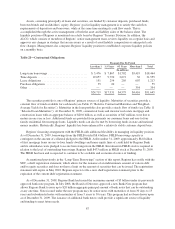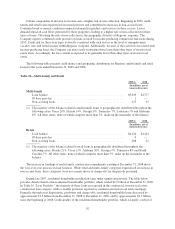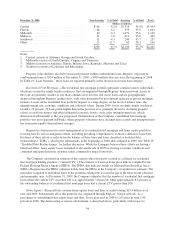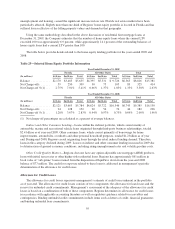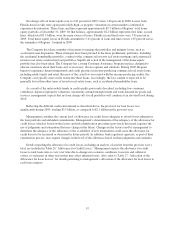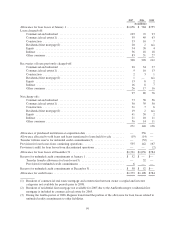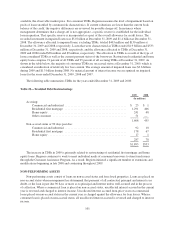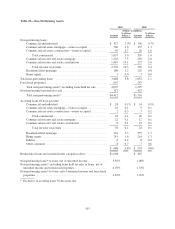Regions Bank 2009 Annual Report Download - page 111
Download and view the complete annual report
Please find page 111 of the 2009 Regions Bank annual report below. You can navigate through the pages in the report by either clicking on the pages listed below, or by using the keyword search tool below to find specific information within the annual report.Net charge-offs on home equity rose to 2.63 percent in 2009 versus 1.46 percent in 2008. Losses from
Florida-based credits were again particularly high, as property valuations in certain markets continued to
experience deterioration. These loans and lines represent approximately $5.7 billion of Regions’ total home
equity portfolio at December 31, 2009. Of that balance, approximately $2.2 billion represents first liens; second
liens, which total $3.5 billion, were the main source of losses. Florida second lien losses were 7.01 percent in
2009. Total home equity losses in Florida amounted to 5.41 percent of loans and lines versus 1.05 percent across
the remainder of Regions’ footprint in 2009.
The Company has taken a number of measures to manage the portfolios and mitigate losses, such as
accelerated asset disposition. These strategies have been pursued in the more problematic portfolios, including
the residential homebuilder portfolio, a subset of the commercial investor real estate mortgage and commercial
investor real estate construction loan portfolios, Significant action in the management of the home equity
portfolio has also been taken. The Company has a strong Customer Assistance Program in place, designed to
educate customers about their loans and, as necessary, discuss options and solutions. During 2009, Regions
began to experience deteriorating trends and credit pressure in income-producing commercial real estate loans,
including multi-family and retail. Because of the cash flow associated with the income-producing credits, the
Company can typically more easily restructure these loans. Accordingly, the loss content is expected to be
generally lower than other types of investor real estate loans, such as residential homebuilder loans.
As a result of the unfavorable trends in credit quality previously described, including low consumer
confidence, depressed property valuations, uncertainty around unemployment and weak demand for goods and
services, management expects that net loan charge-offs for all portfolios will continue at an elevated level during
2010.
Reflecting the difficult credit environment as described above, the provision for loan losses rose
significantly during 2009, totaling $3.5 billion, as compared to $2.1 billion in the previous year.
Management considers the current level of allowance for credit losses adequate to absorb losses inherent in
the loan portfolio and unfunded commitments. Management’s determination of the adequacy of the allowance for
credit losses, which is based on the factors and risk identification procedures previously discussed, requires the
use of judgments and estimations that may change in the future. Changes in the factors used by management to
determine the adequacy of the allowance or the availability of new information could cause the allowance for
credit losses to be increased or decreased in future periods. In addition, bank regulatory agencies, as part of their
examination process, may require changes in the level of the allowance based on their judgments and estimates.
Details regarding the allowance for credit losses, including an analysis of activity from the previous year’s
total, are included in Table 26 “Allowance for Credit Losses.” Management expects the allowance for credit
losses to total loans ratio to vary over time due to changes in economic conditions, loan mix and collateral
values, or variations in other factors that may affect inherent losses. Also, refer to Table 27 “Allocation of the
Allowance for Loan Losses” for details pertaining to management’s allocation of the allowance for loan losses to
each loan category.
97


